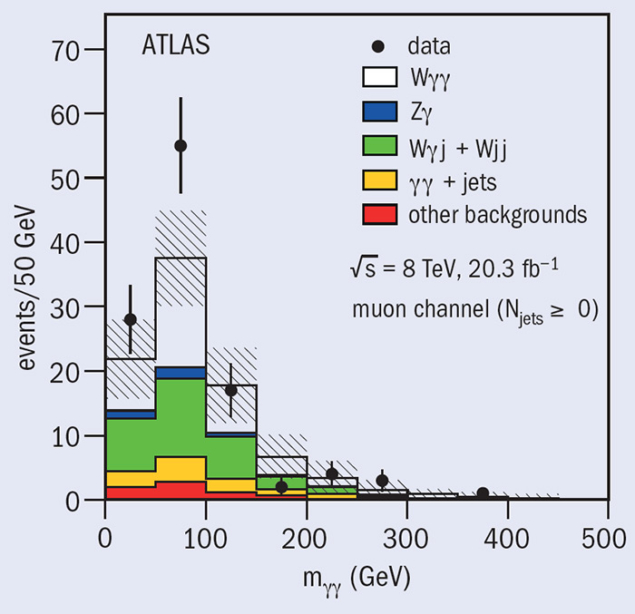Experiments at the LHC have been exploring every corner of predictions made by the Standard Model in search of deviations that could point to a more comprehensive description of nature. The LHC detectors have performed superbly, producing measurements that, to date, are consistent with the model in every area tested, the discovery of the Higgs boson with Standard Model properties being a crowning achievement of LHC Run 1 data-taking.

The ATLAS and CMS collaborations are now looking into deeper levels of Standard Model predictions by probing additional ways in which the gauge bosons (W+, W–, Z and photon) interact with each other. These self-interactions are at the heart of the model’s electroweak sector. The gauge bosons are predicted to interact through point-like triple and quartic couplings. The triple-gauge couplings have been tested both at the LHC and at Fermilab’s Tevatron, following on from beautiful studies at the Large Electron–Positron collider that demonstrated the existance of these couplings and measured their properties. A new frontier at the LHC is to explore the quartic coupling of four gauge bosons. This can be done through the two-by-two scattering of the bosons, or more directly through the transition of one of the bosons to a final state with three bosons.
The ATLAS experiment has used data collected in 2012 from 8 TeV proton–proton collisions to make a measurement of triple-gauge boson production. The measurement isolates a final state with a W boson decaying to leptonic final states eν or μν plus the production of two photons with transverse energy ET > 20 GeV, and additional kinematic requirements defined by the acceptance of the ATLAS detector and the need to suppress soft photons. This process is sensitive to possible deviations of the quartic-gauge coupling WWγγ from Standard Model predictions.
The rate of WWγγ is six orders of magnitude lower than that of inclusive W production. The isolation of this signal is a challenge, owing to both the small production rate and competition from similar processes containing a W boson with jets and single photons. The measurement relies upon the ability of the ATLAS electromagnetic calorimeter to select isolated, directly produced photons from those embedded in the more prolific production of hadronic jets. The figure shows the m(γγ) mass distribution from the 110 events that pass the final pp → W(μν) γγ + X selection cuts. The data are compared with the sum of backgrounds plus the Wγγ signal expected from the Standard Model.
These data are used to put limits on deviations of the quartic gauge coupling WWγγ from Standard Model predictions by introducing models for anomalous (non-Standard Model) contributions to pp → Wγγ + X production. These contributions typically enhance events with large invariant mass of the two photons. The anomalous quartic coupling limits are imposed using a subset of the pp → Wγγ + X events with m(γγ) > 300 GeV and no central high-energy jets. The resulting limits on various parameters that introduce non-Standard Model quartic couplings show that they are all consistent with zero (ATLAS Collaboration 2015). Once again, the Standard Model survives a measurement that probes a new aspect of its electroweak predictions.





